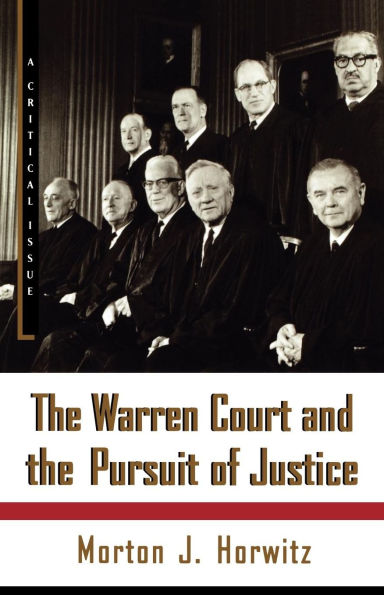Read an Excerpt
Chapter One
Constituting the Warren Court
This book seeks to capture one of the most eventful and influential periods in the history of the United States Supreme Court--the sixteen years between 1953 and 1969 during which Earl Warren served as Chief Justice. From the perspective of more than a quarter century later, the Warren Court is increasingly recognized as having initiated a unique and revolutionary chapter in American constitutional history. Beginning with its first major decision declaring racial segregation unconstitutional in Brown v. Board of Education (1954), the Court regularly handed down opinions that have transformed American constitutional doctrine and, in turn, profoundly affected American society.
The range of the Warren Court's influence has been enormous. The Court initiated a revolution in race relations; expanded the constitutional guarantee of "equal protection of the laws"; dramatically expanded the protections of freedom of speech and press; overturned unequally apportioned legislative districts; accorded defendants in criminal cases massively expanded constitutional protections; and recognized for the first time a constitutional right to privacy.
Before we can understand the Warren Court revolution, it is necessary to realize that when we break into the flow of history in order to focus intensively on a particular period, we may underestimate the importance of events that preceded and followed our own specific period. So, for example, we should not assume that Brown v. Board of Education came out ofnowhere. Rather, the stage was already set for Brown by earlier struggles over racial segregation.
Just as important, while it is convenient to terminate our study of the Warren Court in 1969, when Chief Justice Warren resigned, we should not be misled into thinking that the influence of the Warren Court ended the day Earl Warren retired. Two of the most famous post-Warren Court decisions, for example, were deeply influenced by constitutional changes initiated earlier by the Warren Court. Roe v. Wade (1973), establishing a woman's constitutional right to an abortion, and Furman v. Georgia (1972), declaring existing capital punishment laws unconstitutional, were handed down after the Warren Court had formally come to a close. Similarly, the first case extending the Constitution to bar gender discrimination, Reed v. Reed (1971), was decided only after the Warren Court had passed into history. Yet the path had been prepared by Warren Court decisions expanding the scope of the Equal Protection Clause of the Fourteenth Amendment. As long as we bear in mind that any effort to study a particular period may unconsciously understate what went before or came after, the benefits to be derived from an intensive historical focus seem clearly worth it.
The Justices of the Warren Court
The Warren Court is not just an abstraction. It consisted of individual justices--who constitute an extraordinarily able and interesting group--with different backgrounds and different viewpoints about law and life. We need to focus first on the justices who made up the liberal majority that produced the Warren Court revolution.
When Earl Warren was appointed Chief Justice by President Eisenhower in 1953, only two of the justices who would eventually constitute the future liberal majority were already on the bench. First was Hugo L. Black of Alabama, a New Deal stalwart in the United States Senate, who, in 1937, became President Franklin Delano Roosevelt's first appointment to the Court. Before being elected to the Senate, he had served as a part-time police court judge and county prosecuting attorney.
Shortly after his nomination to the Court had been confirmed by the Senate, it was revealed that Black had once been a member of the racist Ku Klux Klan in Alabama. He explained that he had remained a member for only two years and had long since resigned. Indeed, it may have been impossible to be elected in Alabama without Klan membership. As we shall see, Black repudiated this part of his heritage and was one of the first justices strongly to support the view that the Court needed to overrule its earlier decisions legitimating racial segregation.
Black was raised in a Southern evangelical Baptist family. His religious background is crucial in understanding his strong reading of the First Amendment as requiring a "wall of separation" between church and state, and also his extremely doctrinaire views on how to interpret the text of the Constitution. "[The] Constitution is my legal bible," he once proclaimed; "its plan of our government is my plan and its destiny my destiny. I cherish every word of it, from the first to the last, and I personally deplore even the slightest deviation from its least important commands." Black always carried a copy of the Constitution in his jacket pocket, perhaps imitating the manner in which his evangelical forebears regularly carried copies of the Bible.
The other liberal justice already on the Court when Warren became Chief Justice was William O. Douglas, one of the most brilliant and irascible figures ever to sit on the Court. Appointed at the age of forty-one in 1939 by President Roosevelt, Douglas was the second youngest person ever named to the Court. He retired after serving longer (thirty-six years) than any other Justice, breaking Black's record of thirty-four years.
[CHAPTER ONE CONTINUES...]






